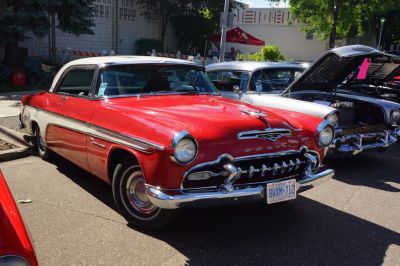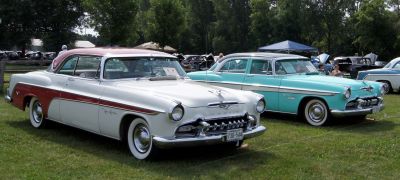 1955 DeSoto Firedome II Special Coupe Dimensions, Size & Specs
1955 DeSoto Firedome II Special Coupe Dimensions, Size & SpecsMeasurements of the 1955 DeSoto Firedome II Special Coupe, engineered for optimal performance and comfort
| Dimensions | |
|---|---|
| Length: | 5535 mm217.9 in18.2 ft |
| Width: | 1989 mm78.3 in6.5 ft |
| Height: | 1539 mm60.6 in5.0 ft |
| Ground Clearance: | 160 mm6.3 in0.5 ft |
The 1955 DeSoto Firedome II Special Coupe is a classic American car from the mid-1950s that combines striking design with notable dimensions reflective of its era. Produced between 1954 and 1955, this coupe has an overall length of 5535 mm (217.9 inches), showcasing its sizeable presence on the road for a two-door vehicle. With a width measuring 1989 mm (78.3 inches), the Firedome II Special Coupe offers a broad stance, contributing both to interior spaciousness and road stability. Its height stands at 1539 mm (60.6 inches), which complements the coupe's aerodynamic profile while still providing comfortable headroom for passengers.
The vehicle’s ground clearance is 160 mm (6.3 inches), balancing the need for a smooth city or highway ride with adequate clearance to handle uneven road surfaces common in the 1950s. As a mid-1950s coupe, the DeSoto Firedome II Special exudes vintage charm while reflecting the era's automotive engineering priorities: sizable dimensions for spacious interiors and road presence, paired with robust build quality. Enthusiasts and collectors appreciate the Firedome II's commanding size and distinctive styling, which make it a standout example of classic American coupe design.
Discover the standout features that make the 1955 DeSoto Firedome II Special Coupe a leader in its class
Have a question? Please check our knowledgebase first.
The 1955 DeSoto Firedome II Special Coupe measures 5535 mm (217.9 inches) in length, 1989 mm (78.3 inches) in width, and stands 1539 mm (60.6 inches) tall. These dimensions make it a substantial full-size coupe typical of mid-1950s American cars, offering a notable road presence and spacious interior compared to smaller vehicles of the era.
With a width of 1989 mm (78.3 inches), the DeSoto Firedome II is relatively wide, which provides a stable road grip and spacious cabin for passengers. However, this width may make parking in tight spaces or narrow city streets more challenging, especially compared to modern compact cars. Drivers should be mindful when navigating confined areas.<br>Its significant width reflects typical mid-century American design focused on comfort rather than urban maneuvering.
The ride height of the 1955 DeSoto Firedome II Special Coupe is 160 mm (6.3 inches). This moderate ground clearance balances road comfort with vehicle stability. It is sufficient for everyday paved road conditions common in the 1950s but might be less suited for uneven terrain or deep snow. The clearance ensures a smooth ride by absorbing road irregularities while maintaining a low center of gravity for handling.
Standing at 1539 mm (60.6 inches) tall, the DeSoto Firedome II Special Coupe has a relatively low roofline characteristic of stylish coupes of its era. This height contributes to a sleek profile but may restrict headroom slightly compared to taller sedans or modern SUVs. However, it enhances aerodynamic styling and provides good forward visibility for the driver while maintaining a sporty, low stance.
The 1955 DeSoto Firedome II Special Coupe, measuring 5535 mm (217.9 inches) long and 1989 mm (78.3 inches) wide, is quite large compared to modern vehicles. While it would fit into a typical garage with an interior length of about 6 meters (20 feet) and width around 2.4 meters (8 feet), the fit is snug, especially width-wise. Drivers should measure their garage space carefully before parking, given the car’s generous size typical of the 1950s American full-size vehicles.
Compared to the previous Firedome generation, the 1955 Firedome II Special Coupe is slightly larger in nearly all dimensions. The 1954 model was somewhat shorter and narrower, emphasizing a more compact approach, while the 1955 version increased in length and width to enhance passenger comfort and road presence. This dimensional growth reflects the automotive trend of the mid-1950s, favoring more spacious and stylish full-size cars to attract consumers seeking luxury and status.
The 1955 DeSoto Firedome II Special Coupe was competitive in size with other American full-size coupes of the mid-1950s. For example, it is similar in length and width to contemporaries like the 1955 Chrysler New Yorker and the Pontiac Star Chief. These vehicles typically measured around 5.3 to 5.5 meters (210 to 217 inches) in length and close to 2 meters (78 to 80 inches) wide. The Firedome II’s size provided ample space and a commanding road presence typical of luxury or premium models in that era.
While exact official curb weight figures for the 1955 DeSoto Firedome II Special Coupe vary, it is estimated to weigh approximately 1800 to 1900 kg (about 4000 to 4200 lbs). This considerable weight is due to its large steel body, robust frame, and heavy V8 engine. Though the weight contributes to a solid, stable ride, it also affects acceleration and fuel economy negatively when compared with lighter vehicles. However, the Firedome’s powerful engine was designed to compensate and provide respectable performance for the time.
The 1955 DeSoto Firedome II Special Coupe was equipped with the famed HEMI V8 engine, a 292 cubic inch (4.8-liter) V8 producing around 230 horsepower. This engine was known for its hemispherical combustion chambers, providing efficient airflow and higher power output compared to many contemporaries. The Firedome's powerful V8 allowed for smooth acceleration and robust performance, distinguishing it in the mid-size luxury segment and enhancing driving pleasure for enthusiasts.
The design and size of the 1955 DeSoto Firedome II Special Coupe embody the mid-1950s American automotive trends, characterized by longer, wider, and lower cars with dramatic styling cues. Its large dimensions and pronounced curves emphasized luxury and road presence, appealing to buyers seeking status and comfort in the booming post-war economy. The coupe’s sleek roofline and substantial width were typical of the era’s aesthetic priorities, blending sporty styling with practical interior space.
Discover similar sized cars.

| Production: | 1954-1955 |
|---|---|
| Model Year: | 1955 |
| Length: | 5535 mm217.9 in |
| Width: | 1989 mm78.3 in |
| Height: | 1539 mm60.6 in |

| Production: | 1954-1955 |
|---|---|
| Model Year: | 1955 |
| Length: | 5535 mm217.9 in |
| Width: | 1989 mm78.3 in |
| Height: | 1539 mm60.6 in |
